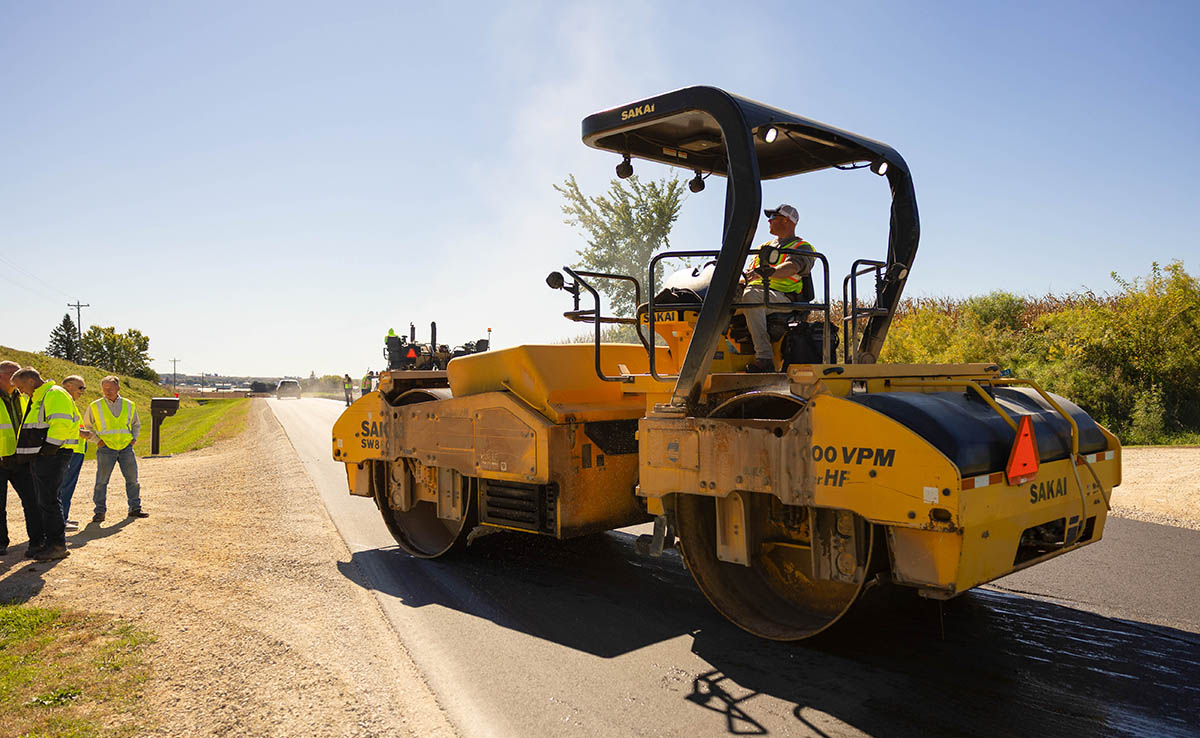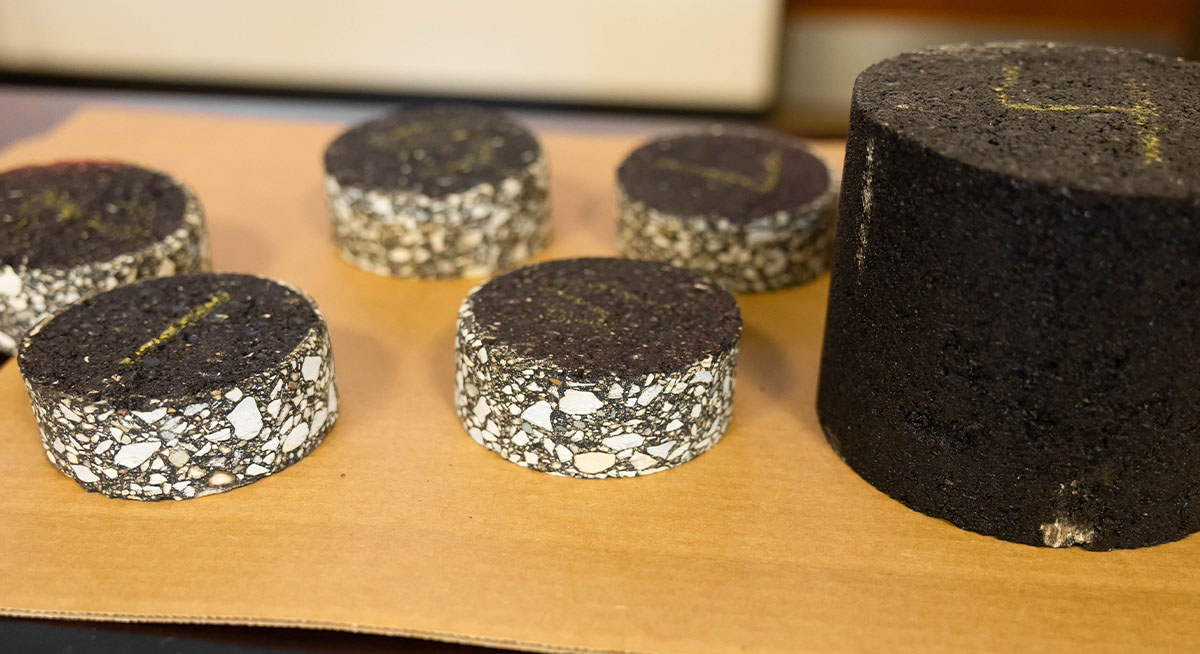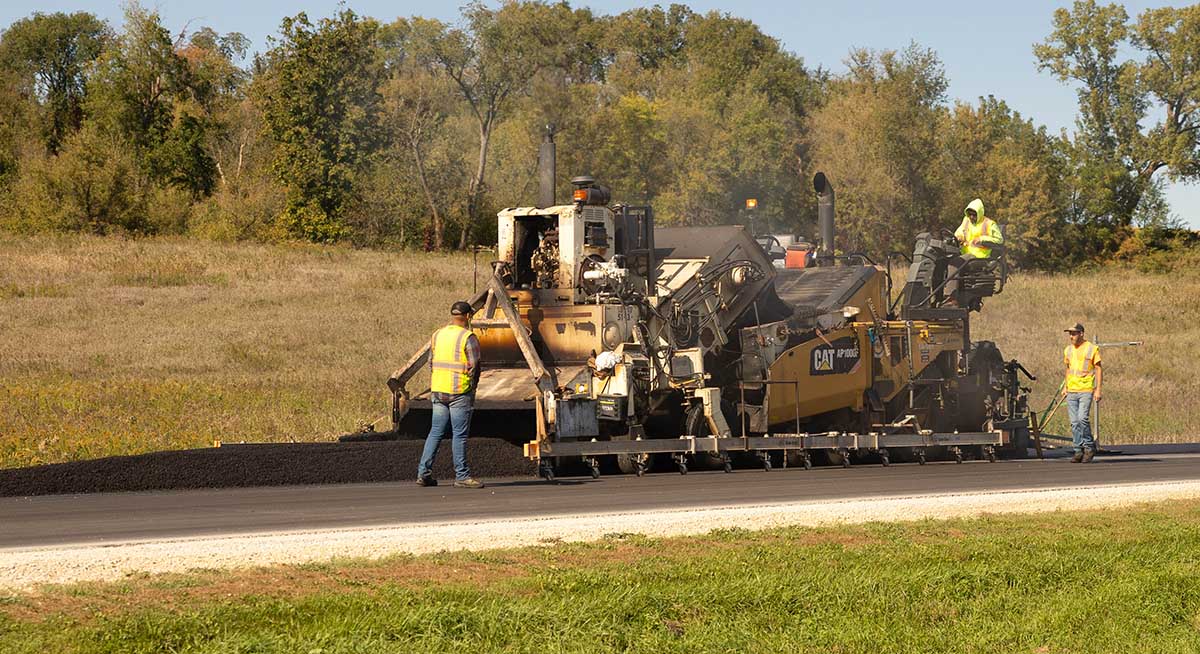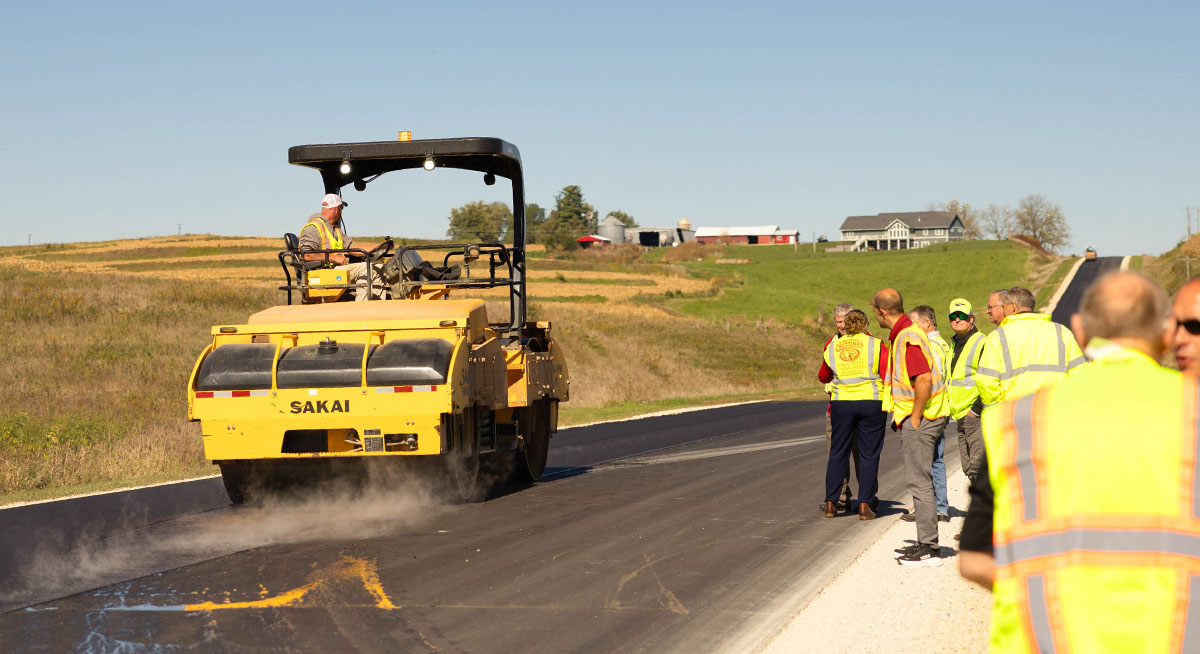
(Photo: Iowa Soybean Association / Joclyn Kuboushek)
Soybeans pave the way in northeast Iowa
October 30, 2025 | Brock Johnston
Amid ongoing international trade uncertainty, driving domestic soybean demand and enhancing infrastructure remain top of mind for Iowa soybean farmers.
Now, a new soy-based asphalt project in both Clayton and Fayette Counties is proving how farmer-led innovation through the soybean checkoff is helping improve communities and driving demand for U.S. soybeans one road at a time. The project was also the culmination of several years of research at Iowa State University (ISU) with support from the Iowa Soybean Association (ISA) and other stakeholders.
We spoke with Eric Cochran, a professor at ISU’s Department of Chemical and Biological Engineering and the director of the Center for Bioplastics and Biocomposites, and Grant Kimberley, ISA senior director of market development, to learn more about soy asphalt and its latest application in northeast Iowa.

How was ISA involved in bringing this new use to practical application?
Kimberley: Checkoff-funded efforts toward research and technology have been instrumental in making soy-based asphalt a reality through our partners at ISU for more than a decade. Soy’s incorporation in asphalt enhances the product’s durability and longevity and reduces maintenance costs. It also increases demand for soybean oil, improves the product’s environmental footprint and could provide significant cost savings for local infrastructure projects.
Prior to the latest project in northeast Iowa, ISA had supported (in part) testing at an on-ramp project at Auburn University and later at the Varied Industries Tent on Farm Progress Show grounds near Boone in 2022 and 2024. Since supporting those initial projects, the technology has continued to evolve and improve, leading to better product durability, and ultimately, a growing market opportunity for the soybeans we produce.
How did soy help make this project a reality?
Cochran: Two separate soy‑based materials were used in this project, both developed at ISU and commercialized by SoyLei. The first is SIP‑1111, a 95% soybean oil ‘rejuvenator’. This chemistry soaks into old, oxidized asphalt binder and restores flexibility. This allows contractors to utilize more recycled pavement in their mixes. In the Clayton and Fayette County projects, the rejuvenator product was used to make a foamed asphalt for a 100% recycled "cold-in-place" base layer. This is much like the project completed at the Farm Progress Show in Boone in recent years, but with significantly improved technology from that time. SIP-1111 was also used for a hot-mix asphalt surface layer, using about 30% recycled pavement.
The second product used was SIP‑1132, a clear, penetrating fog seal that protects the road surface and lane markings. It turns clear within minutes and typically allows traffic to return in about an hour under ideal weather conditions. This product is also from the same family of soy technologies we demonstrated at the Farm Progress Show grounds.

How much soy asphalt was used in the project in northeast Iowa?
Cochran: The project covered roughly 24 centerline miles, including Clayton County’s B45 and X28, multiple sections of road in Fayette County and Volga’s main street. Approximately 33 tons of soy rejuvenator was used to complete the hot mix work in Clayton County alone. That’s equivalent to roughly 66,000 pounds of soybean oil, or about 6,000 bushels. In total, these projects utilized nearly 60 tons of soybean oil across both counties, or roughly 120,000 pounds (11,000 bushels). When accounting for average yield per acre, that’s nearly 180 acres of soybeans finding a home on local roads.
A separate, but growing, avenue for soybean demand is at the refinery ‘bottom of the barrel,’ where the same SIP‑1111 rejuvenator chemistry can help refiners recover more fuel while upgrading asphalt. This is a durable, home‑state use for soybean oil that compliments biodiesel and renewable diesel production.
What is soy’s role from a cost perspective in local infrastructure projects like this?
Cochran: Because the soy rejuvenator makes the old binder more flexible and cooperative, Fayette County needed 182 fewer tons of foamed asphalt than expected, or a 67% reduction. Even after paying for the rejuvenator technology, the county recorded approximately $97,000 in foam‑binder savings, a budget impact that the county engineers noticed. This technology evolved based on our results from the Farm Progress Show pad and also the on-ramp project at Auburn University, both supported in part by the Iowa Soybean Association.

Are similar projects planned in Iowa?
Cochran: Following a recent demo day and tour, multiple county officials in Iowa inquired about the technology and cost templates. We’re working with the Asphalt Paving Association of Iowa and a network of county engineers to tee up more projects using these soy-based products. This includes additional high-RAP (recycled asphalt pavement) hot‑mix jobs using SIP‑1111 and more recycling‑first jobs where the rejuvenator can reduce the foamed‑asphalt requirement. On the maintenance side, agencies are also piloting the clear fog seal (SIP‑1132) to extend striping life without repainting.
A separate, but growing, avenue for soybean demand is at the refinery ‘bottom of the barrel,’ where the same SIP‑1111 rejuvenator chemistry can help refiners recover more fuel while upgrading asphalt. This is a durable, home‑state use for soybean oil that compliments biodiesel and renewable diesel production
Reader Glossary:
- SIP‑1111 (soy rejuvenator): chemistry that restores aged asphalt binder so contractors can safely raise RAP contents in hot‑mix and counties can use less foam binder during cold‑in‑place recycling. This was the source of Fayette’s day‑one savings. Refineries use this same chemistry to improve asphalt quality while increasing fuel recovery.
- SIP‑1132 (clear fog seal): a topical, penetrating treatment for asphalt surfaces that extends life without repainting lines; it goes on milky, turns clear, and typically reopens to traffic in about an hour in sunny 60°F conditions. It’s also sold as an asphalt shingle maintenance product.
- SIP‑1133 (asphalt and concrete sealer): a fast‑dry, no‑sand sealer for streets, bridge decks, and lots that reopens quickly and runs at less than half the cost per square yard of common silane‑based sealers. This product was not used in the Clayton/Fayette County projects, but was recently purchased by Page County and is being applied in some areas in Missouri next week.
Written by Brock Johnston.
Back